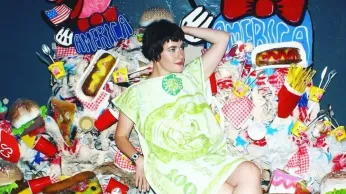
Nov 14
Ten Years of Glitter, Grit, and Queer Joy: Club Silencio Bows Out—But Its Legacy Lives On
READ TIME: 3 MIN.
For ten years, Club Silencio was a neon-lit sanctuary pulsing beneath the heart of London—a place where queerness wasn’t just welcomed, it was worshipped. As the beloved club night takes its final bow, the city’s LGBTQ+ community is collectively reminiscing, mourning, and—true to form—dancing it out one last time. Club Silencio wasn’t just another party; it was a living, breathing monument to queer joy, creativity, and the radical act of gathering together in a world that so often asked us to shrink ourselves .
Created in the spirit of David Lynch’s surreal Parisian haunt, Silencio, the London edition took on a uniquely queer twist—think less Hollywood noir, more drag queens lip-syncing to Kate Bush while the crowd swirls in a haze of glitter and belonging. “Silencio was always about letting your freak flag fly,” recalls Juno Dawson, author and longtime partygoer. “There were nights it felt like the universe only existed within those four walls, and outside, nothing else mattered” .
Queer bars and clubs are more than nightlife—they’re sites of refuge, connection, and resistance. Historically, these spaces have provided cover from a hostile world, giving LGBTQ+ people room to come alive, experiment, and build community. The tradition stretches back to London’s hidden sapphic salons and secretive nightclubs, which evolved from clandestine gatherings to vibrant public celebrations of identity, even as the wider culture tried to keep queer joy in the shadows .
From the Gateways Club of the 1960s—where lesbian London wrote its history on the dance floor—to the legendary Trade nights of the ’90s, London’s queer venues have always been about more than music and drinks. They’re where “everyone was welcome,” as Trade founder Laurence Malice put it—a philosophy echoed by Silencio’s open-door embrace of every queer and trans identity, every gender expression, and every outsider who needed somewhere to belong .
What made Club Silencio stand out wasn’t just its Lynchian ambiance or its star-studded crowd (yes, you could spot drag royalty, authors, and pop stars mingling with wide-eyed newcomers). It was the sense of possibility—a place where you could show up as your boldest self, dance until sunrise, and know you were home. “There was a magic to Silencio,” Dawson says. “Every night was a little act of rebellion—a refusal to be ordinary, a celebration of the weird, the wild, and the wonderful” .
The club’s closing is more than the end of a weekly party; it’s the loss of a community living room, a creative laboratory, and a safe haven. For many, Silencio was the first place they felt truly seen. “We weren’t just partying. We were surviving, together. We were celebrating each other’s triumphs and holding each other through heartbreaks,” one regular reflected, echoing Dawson’s sentiment that Silencio was “where I learned what queer family really means” .
The closing of Club Silencio raises urgent questions about the future of queer nightlife—a culture threatened by gentrification, rising rents, and shifting social landscapes. Each time a venue closes, a little piece of queer history is lost. Yet, as London’s past reminds us, queer communities are resilient: from secret salons to raucous clubs, we’ve always found ways to gather, dance, and create .
As Dawson reflects, “Even as the lights go out on Silencio, the spirit lives on—in every queer night, every drag show, every person who dares to be themselves. We built something beautiful, and its legacy will echo every time someone walks into a club and feels at home” .
The end of Club Silencio isn’t just a farewell—it’s a call to remember, to honor, and to protect the places where our community comes alive. As London’s queer history proves, the dance floor is never truly empty; it just waits for the next generation to fill it with light.
The Power of Queer Gatherings: Lessons from Silencio’s Legacy
- Sanctuary and Self-Expression: Club Silencio, like the hidden salons of yesteryear, offered a haven from the pressures of daily life—a place to experiment with identity and find kinship .
- Community Resilience: Nightlife events have historically doubled as hubs for activism, support, and solidarity—especially in times of crisis .
- Cultural Impact: Queer clubs are creative engines, fueling art, fashion, and music, and providing space for identities that defy mainstream categories .
- Legacy and Memory: Even after their doors close, venues like Silencio live on in the collective memory, inspiring future generations to reclaim space and build new sanctuaries.
As we say goodbye to Club Silencio, we also celebrate its dazzling contribution to London’s queer cultural tapestry—a reminder that no matter how the city changes, queer joy finds a way. The final glitter may have settled, but the beat goes on.






